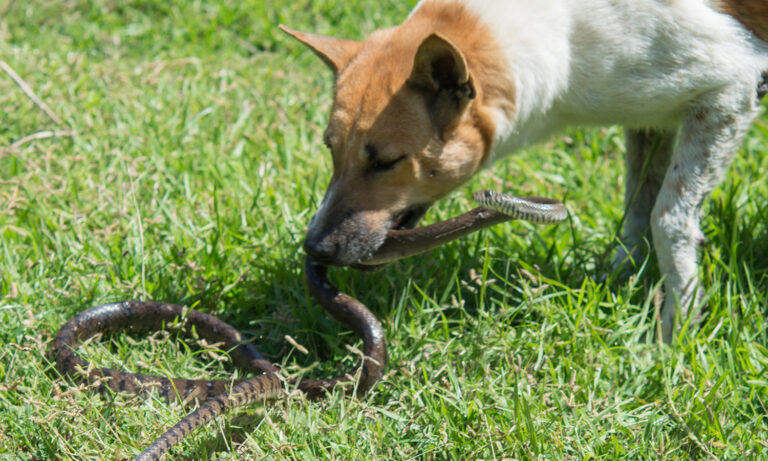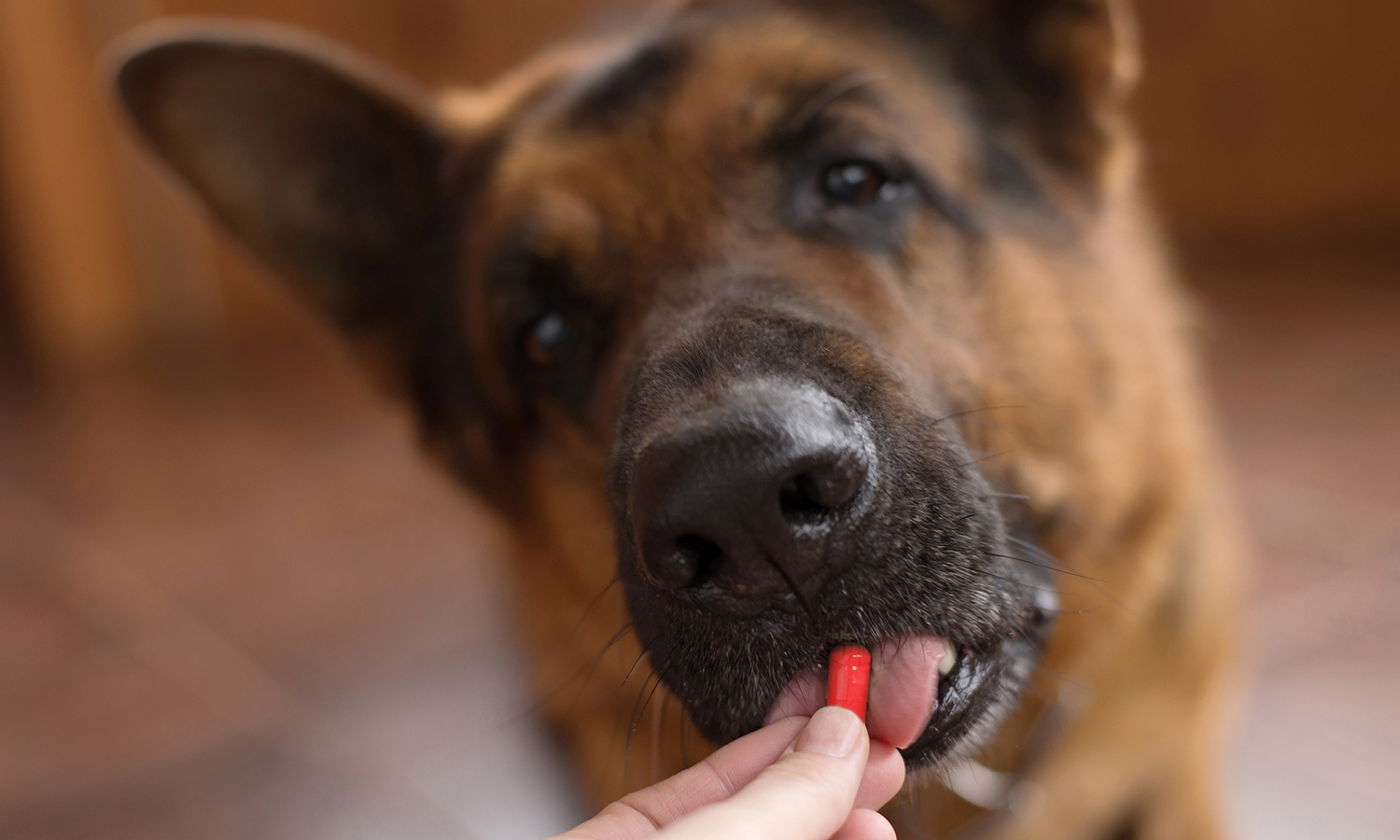
Recognizing Venomous Snakes
First of all, whether your pet is bitten by a venomous or nonvenomous snake, you should always seek veterinary treatment. Nevertheless, it is highly important for you to be able to recognize snakes that are venomous. There are two categories of venomous snakes, and they are elapids and crotalids.
Crotalids – These snakes are grouped in the pit viper family and include water moccasins (cottonmouths), rattlesnakes and copperheads. They are known for their cat-like eyes, heavy bodies and triangle-shaped heads. You will find crotalids most anywhere in North America.
Elapids – While elapids are the most dangerous venomous snakes, the only elapid known in North America is the coral snake. These snakes have black, red, white or yellow bands and are most often found in southern states such as North Carolina and South Carolina, Texas, Florida, Arkansas, Louisiana and Georgia.
Symptoms of Snake Bites in Dogs
Before moving on, it is important to note that not all snakes are poisonous and of those that are, only about 25 percent of them are venomous. However, it can be difficult to determine whether or not the snake that bit your dog was venomous. As such, it is always best to seek treatment from your veterinarian if your pet displays any of the following symptoms.
One or Two Tiny, Bleeding Puncture Wounds
Moderate to Severe Pain Around the Wounds
Moderate to Severe Swelling Around the Snake Bite
Skin Discoloration
Extreme Restlessness
Panting and/or Drooling
Vomiting and/or Diarrhea
Loss of Balance
Respiratory Problems
Shock
Treatments for Snake Bites on Dogs
Fortunately, if your dog gets bitten by a snake, the odds are in favor of a full recovery. If you can identify the snake and you are 100 percent positive it is not venomous, you can clean and dress the wound before going to the vet. However, if you cannot identify the snake, do not clean the wound as water can encourage the venom to spread.
In this case, wrap the wound to stop any bleeding and go to the nearest veterinary hospital or clinic. Since excitement can increase venom’s absorption rate, try to keep your pet calm. If possible, it is also best for you to carry your dog rather than allow it to walk. Do not apply ice to the wounds, attempt to suck out the venom or make any cuts over the bite marks.
Treatment involves neutralizing the effects of venom and stabilizing the respiratory and circulatory systems through the use of such things as intravenous fluids, antihistamines, antivenin and hospitalization. The sooner that antivenin is administered, the better the results. Depending on your dog’s condition, treatment may include anywhere from two to ten vials of antivenin.
Preventing Snake Bites in Dogs
Due to the curious nature of our four-legged friends, snakes and dogs simply do not mix. Nevertheless, there are some things you can do to prevent your pet from getting bitten by a snake. First of all, keep night walks to a minimum and when you are walking your pet, keep it on a leash. Do not allow it to play in bushes or thickly wooded areas.
Keep your dog away from small holes in the ground, flat rocks and old logs as well. When walking in wooded areas, stick close to open paths. If you hear a rattle sound or your dog seems curious about “something” hidden in the brush, back off immediately. When you follow these valuable tips, you will be sure that you and your pet can avoid any snake bites.
—–
My dog has been bitten by a snake. Will he die?
It depends on the species of snake. There are approximately three thousand species of snakes in the world with less than five hundred venomous species. In North America, there are about twenty-five species of venomous snakes; the most common include Rattlesnakes, Copperheads, Cottonmouths (water moccasins), and Coral snakes.
Rattlesnakes Copperheads Cottonmouths Coral snakes Banded rock Prairie Broad-banded Eastern Arizona Black-tailed Red diamond Northern Florida Eastern Canebrake Ridge-nosed Osage Western Texas Diamondback (eastern, western) Sidewinder Southern Western Massasauga (eastern, western) Speckled Trans-Pecos Mojave Tiger Mottled rock Timber Pacific (northern, southern) Twin-spotted Pigmy (southeastern, western)
What are the signs of snakebite?
In dogs bitten by a non-venomous snake, swelling and bruising around the bite are the most common clinical signs. In some cases, it may still be possible to see the paired puncture wounds from the fangs in the center of the wound. The bite may be very painful and may become infected if not treated by a veterinarian. There will be very little progression of the swelling unless infection develops. Most swelling resolves within forty-eight hours in uncomplicated cases.
rattlesnake_snake_envenomization
The clinical signs associated with a venomous snakebite vary based on the species of snake. As a general rule, there is extensive swelling that often spreads quickly. Bleeding or a bloody discharge often occurs at the site of the bite. The puncture wounds from the fangs may not be visible due to either the rapid swelling or the small mouth size of young or small snakes.
“The puncture wounds from the fangs may not be visible due to swelling or the small mouth size of young or small snakes.”
The venom of most North American pit vipers (rattlesnakes and cottonmouths) contains toxic protein components, which produce local and systemic effects. These effects may include local tissue and blood vessel damage, hemolysis or destruction of red blood cells, bleeding or clotting disorders and lung, heart, kidney, and neurologic defects. Pit viper venom can cause shock, hypotension (low blood pressure), and lactic acidemia (a disturbance in the pH of the blood). The venom of most North American pit vipers causes only minor neuromuscular disease, although Mojave and Eastern diamondback rattlesnake venom may cause serious neurologic deficits.
Coral snake venom contains primarily neurotoxic components (components that are toxic to the neurologic system), which result in neuromuscular damage. There are often minimal symptoms and signs seen at the bite site.
How is a diagnosis of snakebite envenomization made?
Diagnosis is primarily made on medical history and clinical signs. If the type of snake is unknown, diagnosis and treatment will be directed at the presenting clinical signs.
What first aid treatment should I do on my way to the veterinarian?
First aid is aimed at reducing rapid spread of venom in the body.
Muzzle your dog to avoid being bitten. Snakebites are painful and your dog may try bite out of discomfort.
If possible, carry the dog rather than allowing the dog to walk.
Keep your pet quiet and warm on the journey to the veterinarian.
Try to keep the area bitten at or below the level of the heart to reduce blood flow to the area.
What is the treatment for snakebite envenomization?
Venomous snakebites are medical emergencies requiring immediate attention. Before treatment is begun, it must be determined whether the snake is venomous and whether envenomization occurred. Fortunately, a venomous snake may bite and not inject venom (dry bites occur in about 20-30% of pit viper bites and in about 50% of all of coral snakebites).
When no envenomization occurs, or if the bite is inflicted by a non-venomous snake, the bite should be treated as a puncture wound. Non-venomous snakebites are generally treated with wound cleaning, antibiotics, anti-histamines and anti-inflammatory medications as indicated.
“The correct treatment of venomous snakebites depends on the type of snakebite.”
The correct treatment of venomous snakebites depends on the type of snakebite.
Copperhead envenomization is usually treated with a combination of antibiotics, anti-histamines, and fluid therapy to counter potential hypotension or shock.
Rattlesnake and coral snake envenomization involve treatment for shock and administering appropriate antivenin. Rattlesnake envenomization is an immediately life-threatening situation and prompt medical assistance must be sought. Coral snake bites are also life-threatening and require immediate administration of appropriate antivenin.
Cottonmouth envenomization may also require antivenin treatment in severe cases.
Treatment to counter shock, low blood pressure, infection and respiratory distress is necessary in most cases of venomous snakebites.
What is the prognosis for a dog bitten by a snake?
The prognosis depends on several factors, including: the size and species of the snake, the amount of venom injected, the number of bites, the location and depth of the bite (bites to the head and body tend to be more severe than bites to the legs or paws), the age, size, and health of the dog, the time elapsed before treatment, and the dog’s individual susceptibility to the venom. The location of the bite is important. Swelling from bites around the muzzle and face can lead to breathing difficulties due to obstruction of the airway.
Copperhead, cottonmouth, and coral snake envenomization cases have a better prognosis for complete recovery than rattlesnake bites.
How can I prevent my dog from being bitten by a snake?
Most snakes will try to avoid people and pets. If you see a snake, the best thing to do is avoid it. When out hiking, stay on open pathways and keep away from snake resting places such as holes, logs, or rocky outcrops. Ideally it is best to keep your dog on leash to prevent startling a snake. Since rattlesnakes are nocturnal, try to hike during the daytime when it is safer. Learn about snakes in your area so you can easily identify the snake and its potential danger.
The biggest mistake pet owners make is attempting to elevate their German Shepherds to their status and think of them as human.
Take trainingt your dog that is at fault.
The more you consider your German Shepherd to be a human, the more your German Shepherd will consider you to be a dog.
If your German




